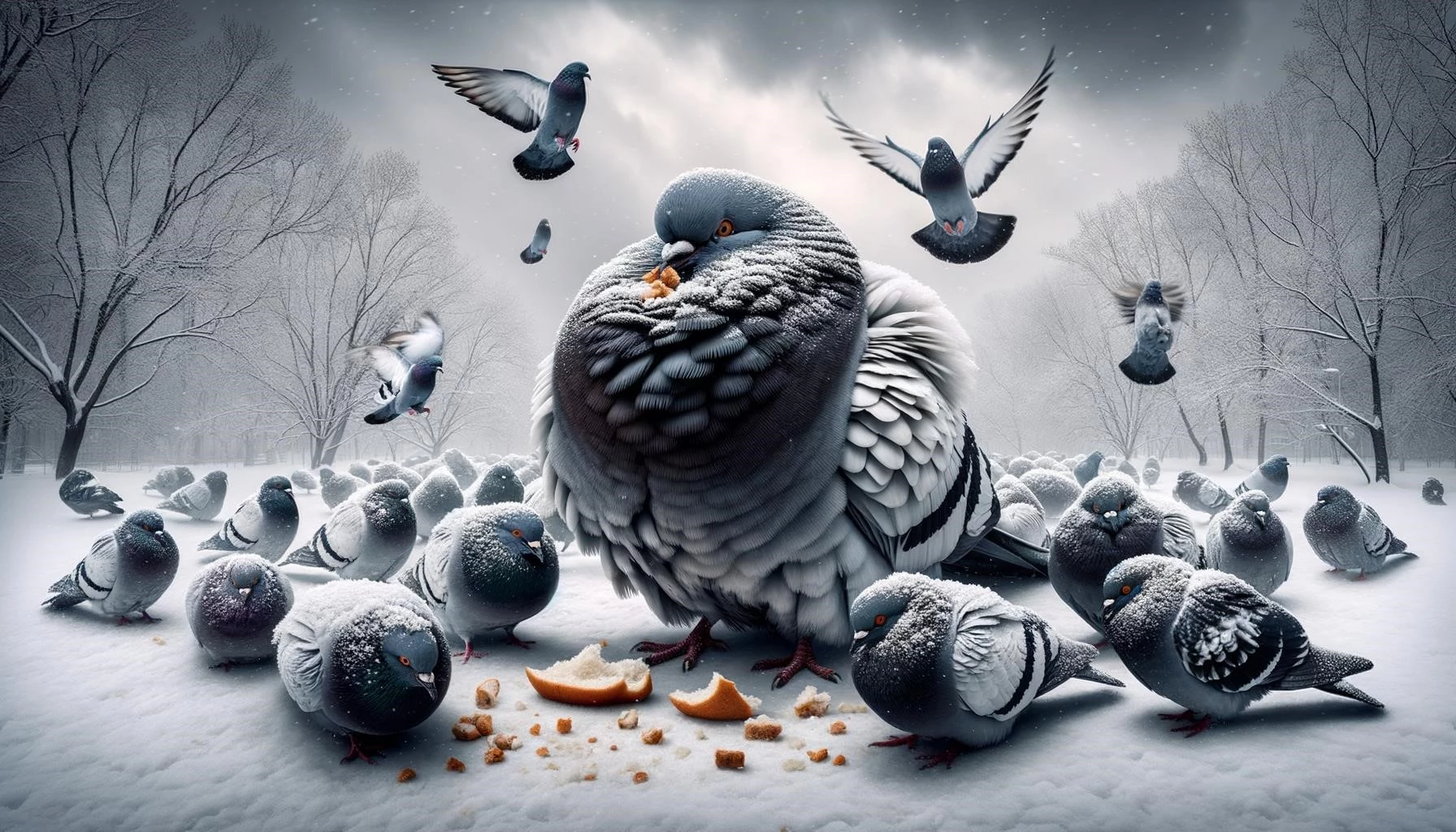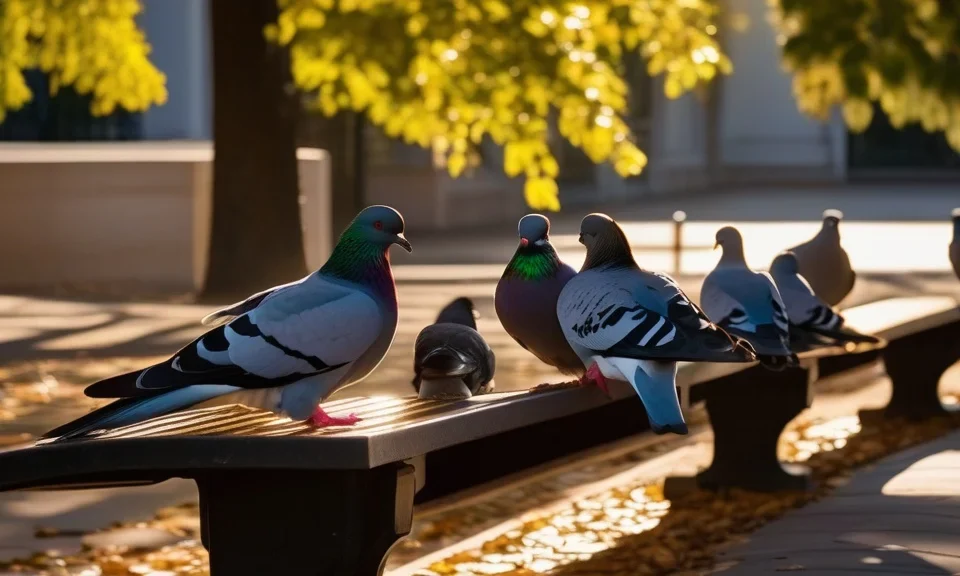How Do Pigeons Survive the Winter?
Pigeons manage to weather the winter by relying on their inherent traits and urban environments. As long as they avoid drafts and damp areas, they can handle the cold quite well. Their primary source of body heat comes from eating, making consistent meals crucial for maintaining their energy levels. During colder months, mixed corn is particularly beneficial, especially when provided at dawn and dusk to help them stay warm.
In urban areas, pigeons seek out warmth near buildings and exhaust vents. These locations offer small pockets of warmth that shield them from severe weather conditions. Although food can be sparse during winter, pigeons are resourceful scavengers who search for scraps left behind by humans to bridge the food gap.
Ultimately, pigeons adjust their eating habits and find suitable shelter to successfully navigate the chilly winter months.
Pigeons’ Cold Tolerance and Adaptations
Pigeons are well-suited to endure cold weather, thanks to a few key adaptations:
- dense, fluffy feathers act as excellent insulators by trapping warmth close to their bodies,
- cleverly take advantage of urban settings for additional warmth,
- possess a high metabolic rate that plays a crucial role in their winter survival.
Their dense, fluffy feathers act as excellent insulators by trapping warmth close to their bodies, which helps maintain a stable internal temperature even when it’s freezing outside.
But it’s not just their plumage that aids them during the winter months. Pigeons cleverly take advantage of urban settings for additional warmth. They often choose nesting sites near buildings and exhaust vents where human activity generates heat, creating cozy spots that protect them from the bitter cold.
Moreover, pigeons possess a high metabolic rate that plays a crucial role in their winter survival. To generate enough energy for staying warm, they must eat frequently. By scavenging for scraps in city environments, they find the sustenance necessary to fuel their active metabolism.
In essence, pigeons rely on a combination of physical insulation, savvy nesting choices, and an energetic metabolism to navigate winter’s challenges with impressive resilience.
Cold Weather Adaptation Techniques
Pigeons have developed various strategies to deal with chilly weather. A major method they use is fluffing their feathers, which traps air and acts as insulation, keeping them warm even when it’s freezing outside. They also tend to huddle together, sharing body heat for extra warmth.
- looking for shelter from cold winds,
- finding refuge in crevices or other protected spots in cities,
- conserving energy during the winter months.
These habits are vital for conserving energy during the winter months and help them endure harsh conditions.
Food Sources and Feeding Habits
Pigeons boast a diverse diet that enables them to endure the winter months. Primarily, they consume grains and seeds, with mixed corn being particularly favored due to its high energy content. Offering this food early in the morning or just before dusk helps them replenish their energy reserves for warmth.
In urban settings, pigeons are known for their resourceful eating behaviors. They often scavenge for human leftovers in places like parks, streets, and around food vendors where discarded scraps abound. By adapting their diet based on available resources, pigeons can compensate for any nutritional deficiencies when natural foods become scarce during colder periods.
Additionally, pigeons have a rapid metabolism requiring frequent feeding. By combining both human-provided meals and scavenging finds, these birds successfully meet their dietary needs even under challenging conditions. This adaptability in their feeding habits is vital for winter survival.
Shelter and Roosting Behavior
Pigeons exhibit unique behaviors when it comes to finding shelter and roosting, crucial for weathering the winter season. They typically select secure spots like ledges and rooftops for resting. Locations near heat sources, such as exhaust vents, are particularly desirable as they offer warmth during chilly conditions. In cities, numerous entry points and nesting sites shield pigeons from the harsh elements.
Finding appropriate shelter becomes vital in colder months to ensure their survival. It helps them avoid the adverse effects of wind and moisture that can be detrimental in severe weather. By strategically choosing their roosting places, pigeons can efficiently maintain body heat throughout winter.
Where Do Pigeons Find Food and Shelter in Winter?
Pigeons are versatile when it comes to their diet, especially in urban areas during the winter. They forage for scraps on streets, in parks, and around buildings. This adaptability allows them to thrive even when natural food sources are scarce. You’ll often find these birds resting on ledges, rooftops, or near warm exhaust vents. Such locations offer both warmth and protection from severe weather, aiding pigeons in enduring the chilly season.
Foraging and Opportunistic Eating
Pigeons are adept at seeking out food and utilizing resources, a vital skill for getting through the winter months. They frequently scavenge for scraps in urban areas like parks, streets, and shopping districts. This adaptability allows them to find sufficient nourishment by tapping into human environments. By capitalizing on these readily available food sources, pigeons manage to fill nutritional voids when natural options are limited during colder seasons. These behaviors help them obtain the energy required to stay warm and sustain a high metabolic rate.
Common Roosting Spots in Urban Areas
Pigeons in urban areas frequently settle on rooftopseavesguttersbalconieswindow ledges, and chimneys. These spots provide them with shelter from the elements and a vantage point to observe their environment. Ideal for nesting and relaxing, these locations offer protection against harsh weather conditions. The way pigeons utilize man-made structures highlights their remarkable adaptability to city living.
Pigeons’ Winter Behavior and Survival Strategies
In the winter months, pigeons adjust their habits to withstand the chilly weather. One important tactic they use is gathering closely together. This behavior allows them to share body heat, significantly cutting down the energy required to stay warm in frigid conditions. By clustering, pigeons can better tolerate freezing temperatures and maintain their health throughout the season.
Additionally, pigeons modify their daily activities to boost their survival odds during winter. Their communal behavior not only helps keep them warm but also fortifies them against environmental hurdles. Such adaptations are crucial for pigeons to flourish despite the challenging circumstances they face at this time of year.
Huddling and Social Behavior
In winter, pigeons showcase remarkable social behavior known as huddling. They cluster together to share body heat, conserving energy in chilly conditions. By forming these tight-knit groups, pigeons require less effort to stay warm. This communal practice not only increases their chances of survival by better enduring the cold but also fortifies social bonds among them, boosting their resilience during harsh winter months.
Challenges Pigeons Face During Harsh Winters
Pigeons face significant challenges during harsh winters, primarily due to the difficulty of finding food and conserving energy. When sustenance is scarce, they struggle to maintain the warmth necessary for survival in the cold. This shortage forces them to expend more energy in their quest for nourishment, which can lead to health issues.
The extreme cold saps pigeons’ strength, making them susceptible to illnesses that decrease their chances of surviving the season. Their ability to weather winter depends greatly on locating sufficient food and conserving energy efficiently. In particularly severe winters, many within a flock may not survive these hardships.
Moreover, inadequate nutrition combined with exposure to freezing temperatures weakens their immune systems, heightening the risk of disease spreading among groups. These conditions underscore the importance of resourcefulness and adaptability for pigeons as they confront winter’s challenges with varying degrees of success.
Limited Food Access and Energy Resources
Pigeons encounter significant difficulties during harsh winters, primarily because food and energy resources become scarce. With fewer people outdoors to drop crumbs, pigeons are forced to travel greater distances in search of sustenance. This increased effort not only challenges their ability to stay warm but also drains their energy reserves. As a result, they face the risk of malnutrition, which can lead to higher mortality rates during particularly severe winters.
To cope with these conditions, pigeons adjust their foraging strategies and make the most of whatever resources they can find in urban environments. Their resilience is put to the test as they navigate these winter obstacles with varying degrees of success. This scenario underscores the importance of adaptability in overcoming seasonal adversities.
Health Issues and Vitality Concerns
When winter arrives, pigeons face the dual challenges of cold stress and food scarcity, both of which can significantly impact their well-being. The frigid temperatures compromise their immune defenses, leaving them vulnerable to illnesses. Moreover, a lack of sufficient food results in malnutrition, depleting the energy essential for their survival. Consequently, pigeons often find it difficult to sustain their vitality and endure the harsh winter environment. This situation underscores the importance of robust immune systems and adequate nutrition to ensure pigeons remain healthy throughout the colder season.









